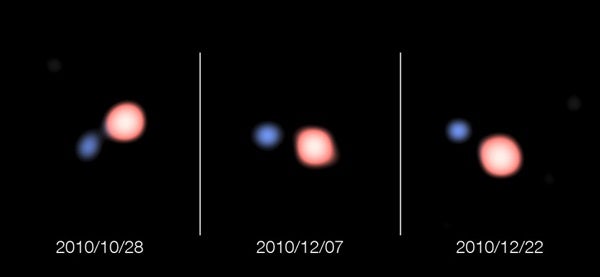“We can now combine light from four very large telescopes and create super-sharp images much more quickly than before,” said Nicolas Blind from IPAG in Grenoble, France. “The images are so sharp that we can not only watch the stars orbiting around each other, but also measure the size of the larger of the two stars.”
The astronomers observed the unusual system SS Leporis in the constellation Lepus the Hare, which contains two stars that circle each other in 260 days. The stars are separated by only a little more than the distance between the Sun and Earth, while the largest and coolest of the two stars extends to one-fourth of this distance — corresponding roughly to the orbit of Mercury. Because of this closeness, the hot companion has already cannibalized about half of the larger star’s mass.
“We knew that this double star was unusual and that material was flowing from one star to the other,” said Henri Boffin from ESO. “What we found, however, is that the way in which the mass transfer most likely took place is completely different from previous models of the process. The ‘bite’ of the vampire star is very gentle but highly effective.”
The new observations are sharp enough to show that the giant star is smaller than previously thought, making it much more difficult to explain how the red giant lost matter to its companion. The astronomers now think that rather than streaming from one star to the other, the matter must be expelled from the giant star as a stellar wind and captured by the hotter companion.
“These observations have demonstrated the new snapshot imaging capability of the Very Large Telescope Interferometer. They pave the way for many further fascinating studies of interacting double stars,”said Jean-Philippe Berger.
“We can now combine light from four very large telescopes and create super-sharp images much more quickly than before,” said Nicolas Blind from IPAG in Grenoble, France. “The images are so sharp that we can not only watch the stars orbiting around each other, but also measure the size of the larger of the two stars.”
The astronomers observed the unusual system SS Leporis in the constellation Lepus the Hare, which contains two stars that circle each other in 260 days. The stars are separated by only a little more than the distance between the Sun and Earth, while the largest and coolest of the two stars extends to one-fourth of this distance — corresponding roughly to the orbit of Mercury. Because of this closeness, the hot companion has already cannibalized about half of the larger star’s mass.
“We knew that this double star was unusual and that material was flowing from one star to the other,” said Henri Boffin from ESO. “What we found, however, is that the way in which the mass transfer most likely took place is completely different from previous models of the process. The ‘bite’ of the vampire star is very gentle but highly effective.”
The new observations are sharp enough to show that the giant star is smaller than previously thought, making it much more difficult to explain how the red giant lost matter to its companion. The astronomers now think that rather than streaming from one star to the other, the matter must be expelled from the giant star as a stellar wind and captured by the hotter companion.
“These observations have demonstrated the new snapshot imaging capability of the Very Large Telescope Interferometer. They pave the way for many further fascinating studies of interacting double stars,”said Jean-Philippe Berger.










